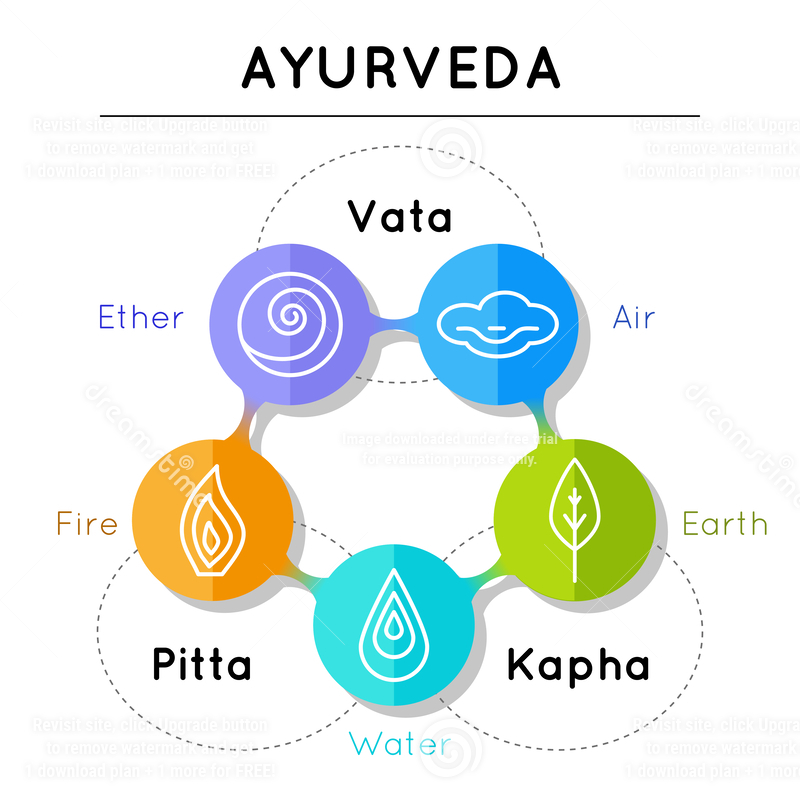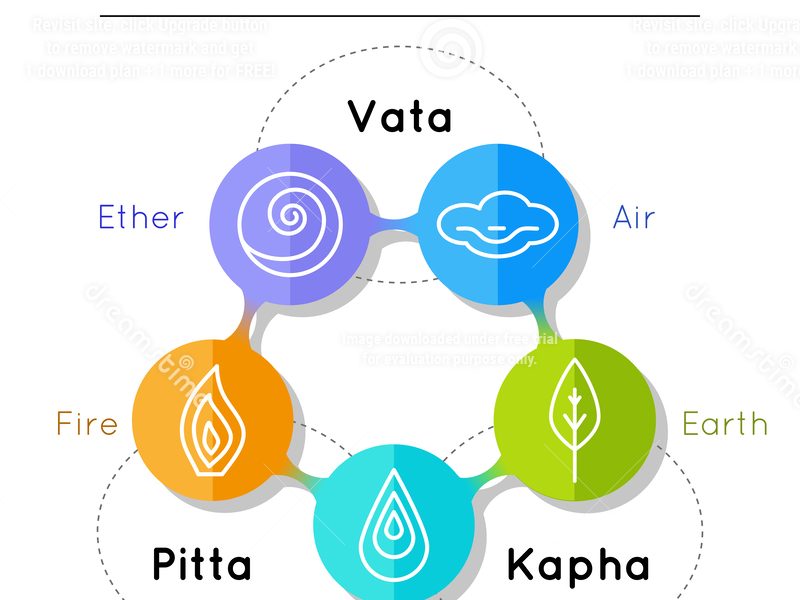In medical astrology, Vedic Astrology uses concepts from its ‘sister science’ Ayurveda. This ancient and medical discipline is based on the five elements which also permeate all Indian traditions and ancient civilisations alike.
From subtle to gross the elements and their Sanskrit names are: ether (akash), air (or wind) (vayu), fire (agni), water (jala) and earth (privthi).
Ayurveda is well known for its capacity to adjust treatments to individually determined body types. Every body type can be described as having a certain percentage of vata, pitta and/or kapha ‘dosha’, which all correspond again to these five elements.
The word dosha can be literately translated as ‘fault’. This already shows that it indicates a disharmony which we will have to deal with in some way or another. This is true, Ayurveda hints that we can adjust our diets and lifestyle to these imbalances that are given to us both by birth and further on the way of the ‘journey of life’.
This is nothing to worry about as we can also see these disharmonies as a fitting part of the greater harmony. It teaches us how to see life as it truly is: beautiful but also perishable. Some knowledge about the dosha can help us to sustain the health of the body.
On other Ayurveda websites it is easy to find more information about the Ayurvedic body types in general: see this one for example, or Times Of India has an elaborate article on this). But I could not find another astrology website where the assessment of determining a body type is explained in full length. Hence, I will share how to determine an Ayurvedic body type in Vedic Astrology.
Ayurvedic body types (doshas) in astrology
Vata is the manifestation of air (or wind) and ether. Pitta manifests fire and water, and kapha of earth and water. Whenever the doshas are in a balance (either corresponding to the birth prikriti or to more or less equal percentages), most people are relatively healthy.

However, if these doshas are out of balance, the body gets prone to diseases corresponding to the unbalanced doshas.
In Ayurveda, normally a doctor (called vaidya in Sanskrit) determines a body type and the (un)balances of the dosas. The Vaidya may distinguish between:
- Prakriti: the body type at birth, and
- Vikruti: the current balance of the doshas in the body.
A vaidya can do physical examination to determine these, which is perhaps the most efficient way. In Vedic Astrology we can find the root-causes of possible imbalances and tune any treatment, lifestyle and spiritual practice to it.
In some cases, efforts are made to restore prakriti. At others times the emphasize lies in balancing the current ‘vikruti’ doshas. Most Ayurvedic treatments include diet, lifestyle, and often also herbs, massages, oils and more interventions can added.
In any medical Vedic Astrology, it is essential to estimate a body type, both prakriti and vikruti. There are also ways in astrology that determine in which of the doshas possible diseases are taking place, but we keep that for another article.
Planets, signs, elements and doshas
Having studied medical astrology from a couple of traditions, I have noticed that there exist some small variations in these categorizations.
Especially the status of Mercury and the sign it rules is debatable. In the teachings of Vāmadeva Śāstrī Mercury is found to be vata, while the lineage of Sanjay Rath Ji clearly states Mercury as relating primarily to the earth element and kapha.
This difference could be explained if we would assume that the manifestation of Mercury (intellect and communication) in the current times is more Vata aggravating as compared to when the original sacred texts were given by the Rishis. For example, the internet and communication via chat can cause a Vata misbalance. And endlessly thinking in cycles without any conclusion can be a symptom of Vata imbalance.
Following information comes from Parasara text[1]Brihat Parasara Hora Shastra (1994), Girish Chand Sharma, page 23.
Planets and Elements
- Sun is a fire planet (pitta).
- Mars is a fire planet (pitta).
- Saturn is an airy planet (vata).
- Mercury is primarily an earth planet (but it’s effects can vary, also depending on conjunctions).
- Moon is a water planet (kapha).
- Venus relates to water (kapha).
- Jupiter relates to ether (and happens to be more kapha).
- Rahu is an air graha (vata).
- Ketu is fiery graha (pitta).
Also in the signs variations are found in different sources. Below, you find an elaboration on the signs and corresponding doshas how I have learned it:
| Sign | Ruler | Notes | Doshas |
| Aries | Mars | Fire sign & Fire planet | Pitta |
| Taurus | Venus | Earth sign but water planet and co-lord is Moon | Kapha & Vata |
| Gemini | Mercury | Air sign and earth planet which changes by influence of other grahas | Vata & Kapha |
| Cancer | Moon | Water sign and planet | Kapha |
| Leo | Sun | Fire sign and planet | Pitta |
| Virgo | Mercury | Earth sign and ruling planet is influenceable Mercury, but co-lord Rahu can add air | Vata & Kapha |
| Libra | Venus | Air sign with water ruler | Kapha & Vata |
| Scorpio | Mars | Water sign and lorded by fire planets Mars and Ketu | Pitta |
| Sagiterius | Jupiter | Fire sign lorded by ether and kapha planet | Kapha & Pitta |
| Capricorn | Saturn | Earth sign lorded by airy planet | Kapha & Vata |
| Aquarius | Saturn | Air sign lorded by airy planets Saturn and Rahu | Vata |
| Pisces | Jupiter | Water sign | Kapha |
Determining Ayurvedic prakriti body type in Vedic Astrology
The birth constitution (Prakriti) is seen from a culmination of the following factors:
- The ascendent and planets therin,
- Placement of ascendent lord,
- The 6th house and planets therein,
- Placement of the 6th house lord,
- Sign placements of other planets.
From the above we can see that it is not really a complicated, but rather a flexible exercise to determine body types in astrology. The art lies in analysing the sign placements with the main focus on the ascendent and 6th house (and their lords).
Vikruti body in astrology(current constitution): influence by time
Estimating a current physical constitution is important in any Ayurvedic medical diagnosis. It is possible to get a good sense about vikruti by analysing a few factors in a chart.
The 6th house of digestion and disease
The reason of the importance of the 6th house is that it is about the digestive system and diseases in general. ‘We become what we eat’ is a popular saying and here we can add the nature of our intestines to the results. Therefore, this 6th house is pivotal for physical constitution.
But there are exceptions. For example, for Taurus lagna, Libra is the ruler of the 6th house and one might expect a high kapha with a little bit of vata. However, if the lords of these houses and/or many other planets are in Leo and Aries, pitta could still be high. Here we see that to determine prakriti from a birth chart remains a bit of a flexible exercise.
The 6th house is the house of diseases. If this house is aspected by malefics without influence from benifics, usually the native has a disease regarding to the dosha of the sign (and planets affecting this house) [2]Brihat Parasara Hora Shastra (1994), Girish Chand Sharma, page 54. Especially if digestive diseases are chronic, they can unbalance the doshas significantly.
Dashas and transits effects on body in astrology
Dasas (planetary time periods) are an additional factor to consider. In these periods the influence from certain planets becomes stronger. If one has just gone through a dasa time period of planets that are related to the 6th house of disease this can leave a big impact. The same accounts for the 8th house of karma .
Some Mahadasa periods take very long. For example, airy planet Saturn’s dasa takes 19 year. At the end of such a period it is quite likely that vata has gone up a bit.

The same counts for transits of malefic planets through the 6ht or 8th houses. The transits of slow moving planets can take a long time too. For example, Saturn takes 2,5 years to move through a sign and Jupiter one full year. The Moon, on the other hand, transits a sign in just about 3 days approximately.
Our actions, the Moon and nakshatras effect on body
Our own actions are affecting Vikruti as well. At the end of the day, planetary influence gets translated into actions. The main significator of our actions is the Moon because it is representing our mind. Many of our actions are decided by our mind (either consciously or unconsciously), and the Moon has a big influence on this.
It is common practice in Vedic Astrology to look at a chart with the Moon as ascendent as well. Especially for the impact of our own behaviour on our health we should do this. Also here, the 6th house from the Moon and the 1st house (so the Moon sign) are important in determining body type.
Moreover, nakshatras play an important role on our mind. Depending on your Moon nakshatra every other nakshatra plays a certain role in your life (this is known as the Navatara). Planets in these nakshatras add to the roles that they are playing in our life.
Nakshatras also are of a dosha type (vata, pitta and kapha) and thus also play a role in this. Some astrology software and apps like Cosmic Insights provide a summary of all doshas of our planets in nakshatras. This can be useful to determine whether our actions would bring particular imbalances.
Of course, at the end of the day there is far more to this. Like for example, the 2nd house of food intake and the 10th house of career can also have large impacts on the vikruti.
All together we can say that Vedic Astrology can provide a good impression about what is going on in the doshas. However, it needs a detailed and holistic approach to come to a proper assessment.
References



